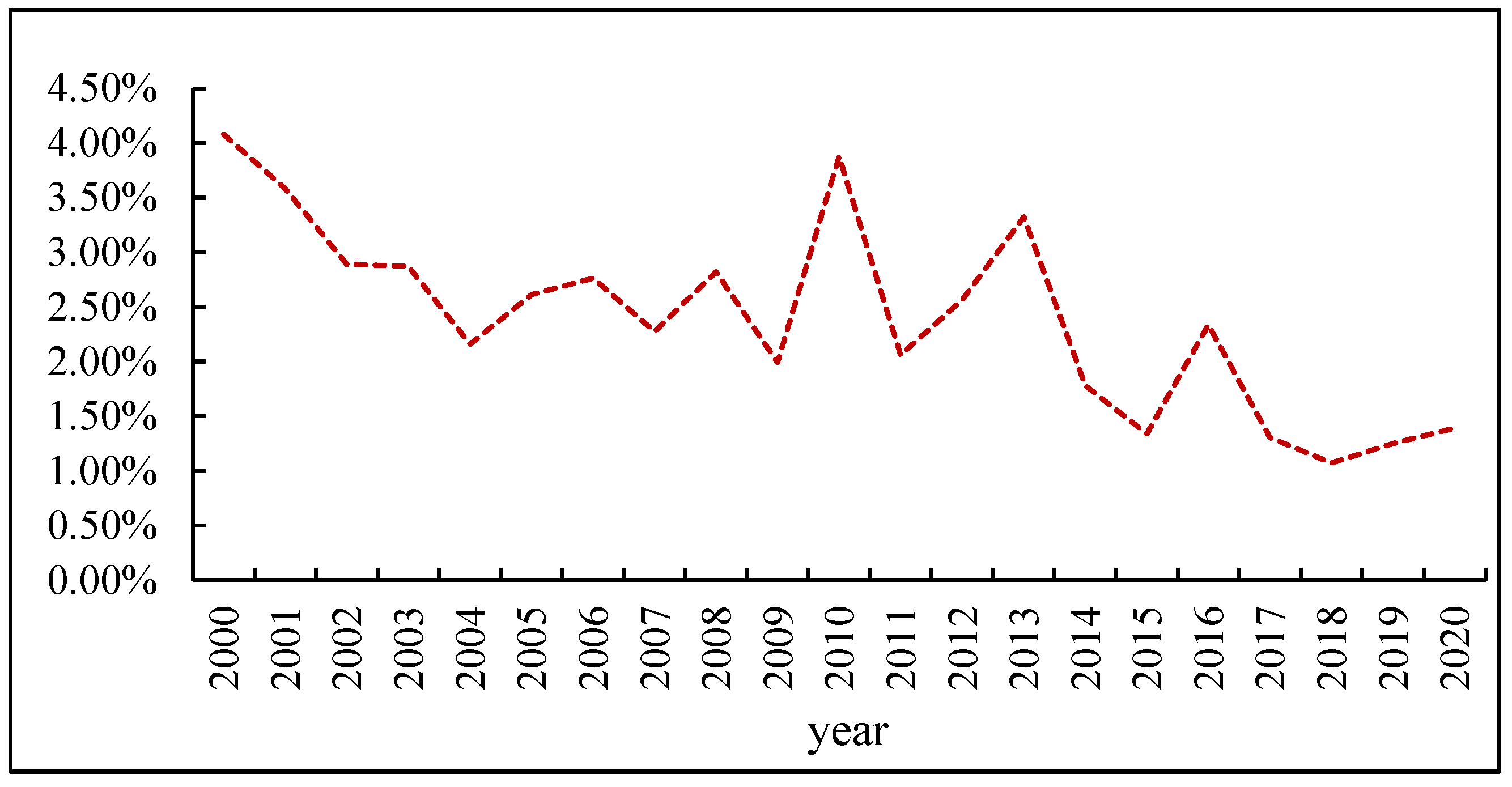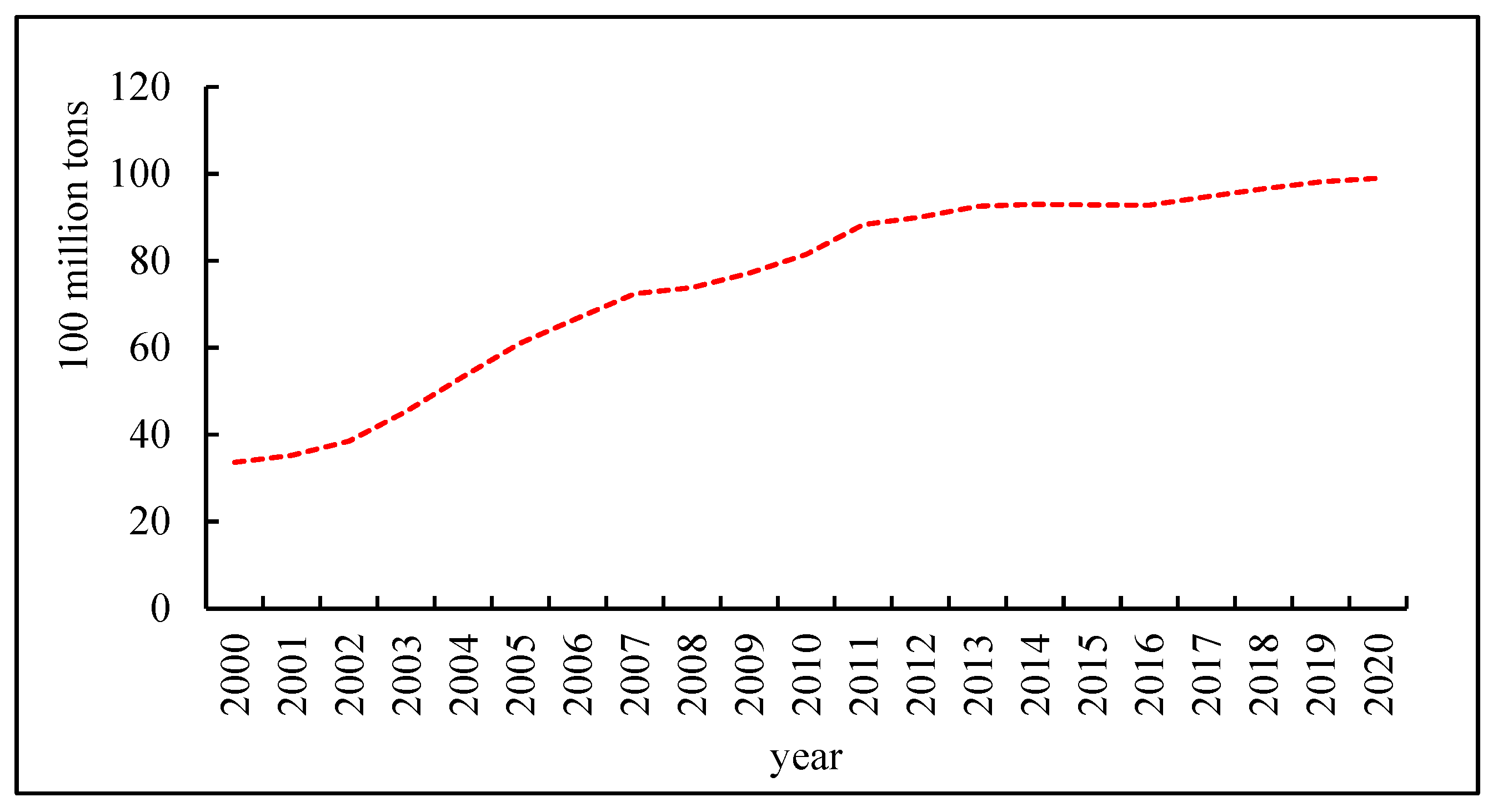You're using an outdated browser. Please upgrade to a modern browser for the best experience.
Please note this is an old version of this entry, which may differ significantly from the current revision.
China has complex geographical and climatic conditions, as well as a wide variety of natural disasters, and this country has the highest frequency of natural disasters in the world. Floods, droughts, earthquakes, typhoons, mudslides, forest fires, and other disasters occur every year, and they have obvious regional, seasonal, and phased characteristics. These frequent natural disasters have severe consequences, such as high death tolls, the destruction of infrastructure, and stagnated regional economic development.
- carbon emissions
- economic growth
- natural disasters
1. Introduction
From 1995 to 2020, the average direct economic losses caused by natural disasters in China each year totaled 300 billion yuan (Figure 1).

Figure 1. The direct economic losses of natural disasters in China.
The direct economic losses caused by natural disasters in China were the highest in the world, and this amount accounted for about 1–4% of the total GDP (Gross Domestic Product) each year (Figure 2). Empirical evidence suggests that natural disasters and environmental damage are inextricably linked, where human economic activity is accompanied by damage to the natural environment, which then further exacerbates the occurrence of natural disasters. In particular, challenges such as extreme weather and temperature rises caused by global climate change are important issues that affect the world at present.

Figure 2. Proportion of direct economic losses as GDP caused by disasters.
In addition, China is the world’s largest energy consumer and its total energy consumption was 4.98 billion tons of standard coal in 2020, where coal consumption accounted for 56.8% of the total energy consumption, and natural gas, hydropower, nuclear power, wind power, and other forms of clean energy consumption accounted for 24.3%. Since 2007, China has surpassed the United States in terms of total carbon emissions and it is ranked first in the world. According to statistics, China’s carbon emissions increased each year from 2000 to 2020 (as shown in Figure 3), and the total carbon emissions were nearly 10 billion tons in 2020, with an average annual growth rate of about 5%. At the 75th session of the United Nations General Assembly in September 2020, China clearly proposed “carbon peaking” by 2030 and “carbon neutrality” by 2060, or the “double carbon” target. This plan vigorously seeks to peak carbon emissions in the years before 2030 and achieve carbon neutrality in the years before 2060. Actively optimizing the energy consumption structure, promoting transformation and upgrading of the industrial structure, and vigorously supporting technological innovation have become important methods for controlling carbon emissions in China.

Figure 3. China’s carbon emissions from 2000 to 2020.
There are complex interactions between the natural environment and social systems, and the outbreak of COVID-19 once again made the impact of natural disasters a hot topic in academia. In particular, the impacts of natural disasters on social development and economic growth have received widespread attention, but few relevant studies have investigated the impacts of natural disasters on carbon emissions, and thus more empirical tests are still needed.
2. Relationships between Natural Disasters and Economic Growth
It is well known that human economic activities can damage the natural environment, but people are more concerned about the impacts of natural disasters on economic development. Obviously, natural disasters will have impacts on regional social development, especially major disasters, which can incur huge costs in terms of casualties and property losses, as well as serious consequences such as inflation, financial deficit, and increased poverty, thereby significantly affecting the physical and mental health of people, and economic growth [1][2][3].
The relationships between economic development and natural disasters have been investigated throughout the world since the mid-1990s, and disaster economics research is currently a hot topic. It is widely accepted that natural disasters have negative impacts on economic growth. In particular, Baig et al. investigated the relationships between natural disasters and economic growth in Pakistan by using the co-integration test method and auto-regressive distributed lag model to show that there was a one-way causal relationship between natural disasters and economic growth in both the short and long term, where natural disasters inhibited economic growth [4]. Kunreuter et al. found that natural disasters lead to large losses and the increased demand for relief materials can crowd out economic development resources to inhibit economic growth [5]. Noy found that natural disasters adversely affected the economy in the short run, but with regional variability, where developed countries were better able to cope with disaster shocks whereas the consequences of natural disasters were more severe in developing countries [6]. Raddatz also concluded that economic growth in low-income countries was more vulnerable to climate disasters after examining disaster data for 112 countries [7].
In addition, some studies found the opposite relationship between disasters and economic growth, where they argued that disasters could also promote economic growth to a certain extent. Based on case studies of disasters in developing countries, Albala et al. found that the post-disaster economic growth of most countries was rapid, thereby indicating that natural disasters can promote economic development to some extent [8]. Skidemore et al. studied the effects of meteorological and geological disasters on economic growth and found that geological disasters had negative impacts on growth, whereas meteorological disasters made positive contributions to economic growth [9]. Davis and Raschky et al. also found that natural disasters played roles in promoting economic growth [10][11].
3. Impacts of Natural Disasters on Energy Consumption and Carbon Emissions
Energy is a necessary basic requirement to support economic and social development, and energy consumption, especially fossil energy use, is a major source of carbon emissions. According to statistics, China’s carbon emissions from energy activities accounted for about 29% of the total global carbon emissions in 2019 and about 87% of China’s total social carbon emissions. Some studies have shown that the impacts of natural disasters on economic development will be transmitted to energy consumption due to the close relationship between the economy and energy [12][13]. Lee et al. studied the relationships between energy and natural disasters in 123 countries and found that natural disasters had negative and significant impacts on the consumption of oil, renewable energy, and nuclear energy and that natural disasters could significantly reduce the demand for energy consumption [14]. Some studies found opposing effects of natural disasters on energy consumption, whereas Doytch et al. found a positive relationship between natural disasters and energy consumption by analyzing panel data from 80 countries [15]. They also found that the impacts of natural disasters on energy consumption varied depending on the economic level, where disasters had positive impacts on renewable energy consumption in high-income economies, positive impacts on industrial energy consumption in low-income economies, and positive impacts on residential energy consumption in middle-income economies. Mishra et al. and Paramati et al. showed that natural disasters caused by climate change can be frequent and that renewable energy sources should replace traditional energy sources (coal, natural gas, and oil) in order to reduce carbon emissions [16][17].
Few studies have examined the impacts of natural disasters on carbon emissions. However, due to the correlation between the economy and energy consumption, it is generally considered that natural disasters will reduce the consumption demand to some extent, and thus restrain carbon emissions [18][19][20][21]. Dou et al. used a set of panel data from 138 countries to test the relationships between natural disasters and carbon dioxide emissions through panel quantile regression. Their empirical results showed that natural disasters significantly reduced carbon emissions, where natural disasters directly reduced carbon emissions but also indirectly contributed to carbon reduction by curbing energy consumption, and the level of technology was an important moderator of the relationship between natural disasters and carbon emissions [22]. There is a lack of reliable conclusions on how natural disasters affect carbon emissions. One explanation is that natural disasters lead to poverty, which in turn reduces energy consumption and ultimately carbon emissions [23][24].
This entry is adapted from the peer-reviewed paper 10.3390/su152115210
References
- Ishizawa, O.A.; Miranda, J.J. Weathering storms: Understanding the impact of natural disasters in Central America. Environ. Resour. Econ. 2019, 73, 181–211.
- Filipski, M.; Jin, L.; Zhang, X.; Chen, K.Z. Living like there’s no tomorrow: The psychological effects of an earthquake on savings and spending behavior. Eur. Econ. Rev. 2019, 116, 107–128.
- Tokui, J.; Kawasaki, K.; Miyagawa, T. The economic impact of supply chain disruptions from the great East-Japan earthquake. Jpn. World Econ. 2017, 41, 59–70.
- Baig, N.; Khan, S.; Gilal, N.G.; Qayyum, A. Do natural disasters cause economic growth? An ARDL bound testing approach. Stud. Bus. Econ. 2018, 13, 5–20.
- Kunreuther, H.; Pauly, M. Rules rather than discretion: Lessons from hurricane Katrina. J. Risk Uncertain. 2006, 33, 101–116.
- Noy, I. The macroeconomic consequences of disasters. J. Dev. Econ. 2009, 88, 221–231.
- Raddatz, C. Are external shocks responsible for the instability of output in low-income countries? J. Dev. Econ. 2007, 84, 155–187.
- Albala-Bertrand, J.M. Political Economy of Large Natural Disasters: With Special Reference to Developing Countries; Clarendon Press: Oxford, UK, 1993; p. 6.
- Skidmore, M.; Toya, H. Do natural disasters promote long-run growth? Econ. Inq. 2002, 40, 664–687.
- Davis, D.; Weinstein, D. Bones, bombs, and break points: The geography of economic activity. Am. Econ. Rev. 2002, 92, 1269–1289.
- Raschky, P.A. Institutions & the losses from natural disasters. Nat. Hazards Earth Syst. Sci. 2008, 8, 627–634.
- Abbas Khan, K.; Zaman, K.; Shoukry, A.M.; Sharkawy, A.; Gani, S.; Sasmoko; Ahmad, J.; Khan, A.; Hishan, S.S. Natural disasters and economic losses: Controlling external migration, energy and environmental resources, water demand, and financial development for global prosperity. Environ. Sci. Pollut. Res. 2019, 26, 14287–14299.
- De Cian, E.; Sue Wing, I. Global energy consumption in a warming climate. Environ. Resour. Econ. 2019, 72, 365–410.
- Lee, C.C.; Wang, C.W.; Ho, S.J.; Wu, T.P. The impact of natural disaster on energy consumption: International evidence. Energy Econ. 2021, 97, 105021.
- Doytch, N.; Klein, Y.L. The impact of natural disasters on energy consumption: An analysis of renewable and nonrenewable energy demand in the residential and industrial sectors. Environ. Prog. Sustain. Energy 2018, 37, 37–45.
- Mishra, G.S.; Zakerinia, S.; Yeh, S.; Teter, J.; Morrison, G. Mitigating climate change: Decomposing the relative roles of energy conservation, technological change, and structural shift. Energy Econ. 2014, 44, 448–455.
- Paramati, S.R.; Mo, D.; Gupta, R. The effects of stock market growth and renewable energy use on CO2 emissions: Evidence from G20 countries. Energy Econ. 2017, 66, 360–371.
- Bui, A.T.; Dungey, M.; Nguyen, C.V.; Pham, T.P. The impact of natural disasters on household income, expenditure, poverty and inequality: Evidence from Vietnam. Appl. Econ. 2014, 46, 1751–1766.
- Cassar, A.; Healy, A.; Von Kessler, C. Trust, risk, and time preferences after a natural disaster: Experimental evidence from Thailand. World Dev. 2017, 94, 90–105.
- Acheampong, A.O. Economic growth, CO2 emissions and energy consumption: What causes what and where? Energy Econ. 2018, 74, 677–692.
- Begum, R.A.; Sohag, K.; Abdullah, S.M.S.; Jaafar, M. CO2 emissions, energy consumption, economic and population growth in Malaysia. Renew. Sustain. Energy Rev. 2015, 41, 594–601.
- Dou, Y.; Shahbaz, M.; Dong, K.; Dong, X. How natural disasters affect carbon emissions: The global case. Nat. Hazards 2022, 113, 1875–1901.
- Ogbeide-Osaretin, E.N. Analysing energy consumption and poverty reduction nexus in Nigeria. Int. J. Sustain. Energy 2021, 40, 477–493.
- Dou, Y.; Dong, K.; Jiang, Q.; Shahbaz, M. How do natural disasters affect energy poverty? Evidence from a global perspective. Singap. Econ. Rev. 2022, 68, 1115–1146.
This entry is offline, you can click here to edit this entry!
